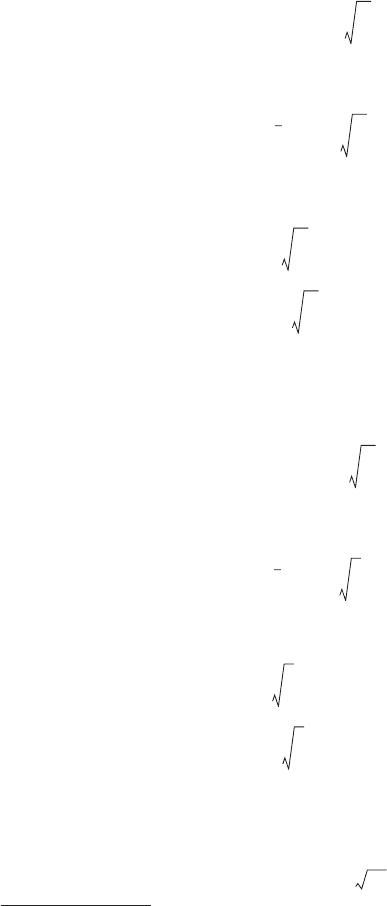Wai-Fah Chen.The Civil Engineering Handbook
Подождите немного. Документ загружается.


© 2003 by CRC Press LLC
15.
16.
17.
18.
19.
20.
21.
22.
Forms Containing (a + bx)
For forms containing a + bx but not listed in the table, the substitution may prove helpful.
23.
24.
25.
a
x
alog xd
∫
a
x
a 0>()=
xd
a
2
x
2
+
----------------
∫
1
a
--
tan
1–
x
a
--
=
xd
a
2
x
2
–
----------------
∫
1
a
--
h
1–
x
a
--
tan
or
1
2a
------
ax+
ax–
-----------
a
2
x
2
>()log
=
xd
x
2
a
2
–
----------------
∫
1
a
--
– h
1–
cot
x
a
--
or
1
2a
------
xa–
xa+
-----------
x
2
a
2
>()log
=
xd
a
2
x
2
–
---------------------
∫
sin
1–
x
a
-----
or
cos
1–
x
a
-----
a
2
x
2
>()–
=
xd
x
2
a
2
±
---------------------
∫
xx
2
a
2
±+
log=
xd
xx
2
a
2
–
------------------------
∫
1
a
-----
sec
1–
x
a
--
=
xd
xa
2
x
2
±
------------------------
∫
1
a
--
aa
2
x
2
±+
x
------------------------------
log–=
u
abx+
x
---------------=
abx+()
n
xd
∫
abx+()
n 1+
n 1+()b
----------------------------
n 1–≠()=
xa bx+()
n
xd
∫
1
b
2
n 2+()
----------------------
abx+()
n 2+
a
b
2
n 1+()
----------------------
abx+()
n 1+
n 1–≠ 2–,( )–=
x
2
abx+()
n
xd
∫
1
b
3
-----
abx+()
n 3+
n 3+
---------------------------- 2a
abx+()
n 2+
n 2+
----------------------------
– a
2
abx+()
n 1+
n 1+
----------------------------
+=

© 2003 by CRC Press LLC
26.
27.
28.
29.
30.
31.
32.
33.
34.
35.
36.
x
m
abx+()
n
xd
∫
x
m 1+
abx+()
n
mn1++
------------------------------------
an
mn1++
-----------------------
x
m
abx+()
n 1–
xd
∫
+
or
1
an 1+()
--------------------
x
m 1+
abx+()
n 1+
– mn2++( ) x
m
abx+()
n 1+
xd
∫
+
or
1
bm n 1++( )
-------------------------------
x
m
abx+()
n 1+
ma x
m 1+
abx+()
n
xd
∫
–
=
xd
abx+
---------------
∫
1
b
--
abx+()log=
xd
abx+()
2
----------------------
∫
1
ba bx+()
-----------------------
–=
xd
abx+()
3
----------------------
∫
1
2ba bx+()
2
-----------------------------–=
x xd
abx+
---------------
∫
1
b
2
----
abxa abx+()log–+[ ]
or
x
b
--
a
b
2
----
abx+()log–
=
x xd
abx+()
2
----------------------
∫
1
b
2
-----
abx+()log
a
abx+
---------------+=
x xd
abx+()
n
----------------------
∫
1
b
2
-----
1–
n 2–()abx+()
n 2–
-----------------------------------------------
a
n 1–()abx+()
n 1–
-----------------------------------------------+
(n ≠ 1, 2)=
x
2
xd
abx+
---------------
∫
1
b
3
-----
1
2
--
abx+()
2
2aa bx+()– a
2
abx+()log+=
x
2
xd
abx+()
2
----------------------
∫
1
b
3
-----
abx 2aabx+()log–
a
2
abx+
---------------–+=
x
2
xd
abx+()
3
----------------------
∫
1
b
3
-----
abx+()log
2a
abx+
---------------
a
2
2 abx+()
2
-------------------------–+=
x
2
xd
abx+()
n
----------------------
∫
1
b
3
----
1–
n 3–()abx+()
n 3–
---------------------------------------------
=
2a
n 2–()abx+()
n 2–
---------------------------------------------
a
2
n 1–()abx+()
n 1–
---------------------------------------------
(n ≠ 1, 2, 3)–+

© 2003 by CRC Press LLC
37.
38.
39.
40.
41.
42.
The Fourier Transforms
For a piecewise continuous function F (x) over a finite interval 0 x π, the finite Fourier cosine
transform
of F (x) is
(1)
If x ranges over the interval 0 x L, the substitution x′ = π x/L allows the use of this definition,
also. The inverse transform is written
(2)
where . We observe that F (x) = F (x) at points of continuity. The formula
(3)
makes the finite Fourier cosine transform useful in certain boundary value problems.
Analogously, the finite Fourier sine transform of F (x) is
(4)
and
(5)
xd
xa bx+()
-----------------------
∫
1
a
--
abx+
x
---------------
log–=
xd
xa bx+()
2
-------------------------
∫
1
aa bx+()
-----------------------
1
a
2
-----
abx+
x
---------------
log–=
xd
xa bx+()
3
-------------------------
∫
1
a
3
-----
1
2
--
2abx+
abx+
------------------
2
x
abx+
---------------
log+=
xd
x
2
abx+()
-------------------------
∫
1
ax
-----–
b
a
2
-----
abx+
x
---------------
log+=
xd
x
3
abx+()
-------------------------
∫
2bx a–
2a
2
x
2
------------------
b
2
a
3
-----
x
abx+
---------------
log+=
xd
x
2
abx+()
2
----------------------------
∫
a 2bx+
a
2
xa bx+()
----------------------------–
2b
a
3
------
abx+
x
---------------
log+=
f
c
n() Fx() nxcos x (nd
0
π
∫
012
K
),,,= =
Fx()
1
π
---
f
c
0()
2
π
---
f
c
n() nx 0 x
π
<<()cos
n 1=
∞
∑
+=
Fx()
Fx 0+()Fx 0–()+[ ]
2
----------------------------------------------------=
f
c
2()
n() F″ x() nxcos xd
0
π
∫
=
n
2
f
c
n()– F′ 0()– 1–()
n
F′
π
()+=
f
s
n() Fx() nxsin x (nd
0
π
∫
123K ),,,= =
Fx()
2
π
---
f
s
n() nx 0 x
π
<<()sin
n 1=
∞
∑
=

© 2003 by CRC Press LLC
Corresponding to (3) we have
(6)
Fourier Transforms
If F (x) is defined for x 0 and is piecewise continuous over any finite interval, and if
is absolutely convergent, then
(7)
is the Fourier cosine transform of F (x). Furthermore,
(8)
If , an important property of the Fourier cosine transform,
(9)
where , makes it useful in the solution of many problems.
Under the same conditions,
(10)
defines the Fourier sine transform of F (x), and
(11)
Corresponding to (9), we have
(12)
Similarly, if F (x) is defined for – ∞ < x < ∞, and if is absolutely convergent, then
(13)
f
s
2()
n() F″ x() nxsin xd
0
π
∫
=
n
2
f
s
n()– nF 0()– n 1–()
n
F
π
()–=
Fx()xd
0
∞
∫
f
c
α
()
2
π
--- Fx()
α
x()cos xd
0
∞
∫
=
Fx()
2
π
--- f
c
α
()
α
x()cos
α
d
0
∞
∫
=
d
n
F
dx
n
---------
x ∞→
lim 0=
f
c
2r()
α
()
2
π
---
d
2r
F
x
2r
d
----------
α
x()cos xd
0
∞
∫
=
2
π
--- 1–()
n
a
2r 2n– 1–
a
2n
1–()'
α
2r
f
c
α
()+
n 0=
r 1–
∑
–=
d
r
F
dx
r
--------
x 0→
lim a
r
=
f
s
α
()
2
π
--- Fx()
α
x()sin xd
0
∞
∫
=
Fx()
2
π
--- f
s
α
()
α
x()sin
α
d
0
∞
∫
=
f
s
2r()
α
()
2
π
---
d
2r
F
dx
2r
----------
ax()sin xd
0
∞
∫
=
2
π
---–
1–()
n
α
2n 1–
a
2r 2n–
1–()
r 1–
α
2r
f
s
α
()+
n 1=
r
∑
=
Fx() xd
∞–
∞
∫
f
α
()
1
2
π
----------
Fx()e
i
α
x
xd
∞–
∞
∫
=

© 2003 by CRC Press LLC
is the Fourier transform of F (x), and
(14)
Also, if
then
(15)
Finite Sine Transforms
f
s
(n) F(x)
1
2
3
4
5
6
7
8
9
10
11
12
13
14
Fx()
1
2
π
----------
f
α
()e
i–
α
x
α
d
∞–
∞
∫
=
d
n
F
dx
n
--------
x ∞→
lim 0= n 12K r 1–,, ,=( )
f
r()
α
()
1
2
π
----------
F
r()
x()e
i
α
x
xd
∞–
∞
∫
i
α
–()
r
f
α
()= =
f
s
n() Fx() nxsin x n 12K,,=( )d
0
π
∫
=
Fx()
1–()
n 1+
f
s
n()
F
π
x–()
1
n
---
π
x–
π
------------
1–()
n 1+
n
------------------
x
π
---
11–()
n
–
n
----------------------
1
2
n
2
-----
n
π
2
------
sin
x when 0 x
π
2⁄<<
π
x when
π
2⁄ x
π
<<–
1–()
n 1+
n
3
------------------
x
π
2
x
2
–()
6
π
------------------------
11–()–
n
n
3
----------------------
x
π
x–()
2
--------------------
π
2
1–()
n 1–
n
------------------------
21 1–()
n
–[]
n
3
------------------------------–
x
2
π
1–()
n
6
n
3
-----
π
2
n
-----–
x
3
n
n
2
c
2
+
---------------
11–()
n
e
c
π
–[ ]
e
cx
n
n
2
c
2
+
---------------
h c
π
x–()sin
c
π
sinh
--------------------------------
n
n
2
k
2
–
---------------
k 012K,,,≠( )
h k
π
x–()sin
sin k
π
---------------------------------
π
2
---
when nm=
m 12K,,=( )
0 when nm≠
mxsin

© 2003 by CRC Press LLC
Finite Cosine Transforms
15
16
17
18
19
f
c
(n) F(x)
1 (n = 0, 1, 2, K)
F(x)
2
3 0 when n = 1, 2, K; f
c
(0) = π
1
4
5
x
6
7
8
x
3
9
10
11 (k ≠ 0, 1, 2, K)
sin kx
12 (m = 1, 2, K)
13 (k ≠ 0, 1, 2, K)
14 0 when n = 1, 2, K;
(m = 1, 2, K)
f
s
(n) F(x)
n
n
2
k
2
–
---------------
11–()
n
k
π
cos–[ ]
k 12K,,≠( )
kxcos
n
n
2
m
2
–
-----------------
11–()
nm+
–[ ]
when nm≠ 12K,,=
0 when nm=
mxcos
n
n
2
k
2
–()
2
----------------------
k 012K,,,≠( )
π
kxsin
2k sin
2
k
π
-------------------------
x kcos
π
x–()
2k k
π
sin
----------------------------------–
b
n
n
----
b 1≤()
2
π
---
arctan
b xsin
1 b xcos–
--------------------------
11–()
n
–
n
----------------------
b
n
b 1≤()
2
π
---
arctan
2b xsin
1 b
2
–
---------------------
f
c
n() Fx() nxcos xd
0
π
∫
=
1–()
n
f
c
n()
F
π
x–()
2
n
---
n
π
2
------
f
c
0();sin 0=
1 when 0 x
π
2⁄<<
1 when
π
2⁄ x
π
<<–
11–()
n
–
n
2
----------------------
f
c
0();–
π
2
2
-----=
1–()
n
n
2
-------------
f
c
0();
π
2
6
-----=
x
2
2
π
------
1
n
2
-----
f
c
0(); 0=
π
x–()
2
2
π
------------------
π
6
---–
3
π
2
1–()
n
n
2
-------------
6
11–()
n
–
n
4
----------------------
f
c
0();–
π
4
4
-----=
1–()
n
e
c
π
1–
n
2
c
2
+
----------------------------
1
c
---
e
cx
1
n
2
c
2
+
---------------
c
π
x–()cosh
cc
π
sinh
------------------------------
k
n
2
k
2
–
---------------
1–()
n
π
k 1–cos[ ]
1–()
nm+
1–
n
2
m
2
–
----------------------------
f
c
m(); 0=
1
m
----
mxsin
1
n
2
k
2
–
---------------
k
π
x–()cos
kk
π
sin
----------------------------–
f
c
m()
π
2
---=
mxcos

© 2003 by CRC Press LLC
Fourier Sine Transforms
Fourier Cosine Transforms
F (x) f
s
(α)
1
2
3
4
5
6
7
* C(y) and S(y) are the Fresnel integrals.
F (x) f
c
(α)
1
2
3
4
5
6
7
10xa<<()
0 xa>()
2
π
---
1
α
cos–
α
---------------------
x
p 1–
0 p 1<<()
2
π
---
Γ p()
α
p
-----------
p
π
2
------
sin
x 0 xa<<()sin
0 xa>()
1
2
π
----------
a 1
α
–()[]sin
1
α
–
----------------------------------
a 1
α
+()[]sin
1
α
+
----------------------------------–
e
x–
2
π
---
α
1
α
2
+
---------------
xe
x
2
2⁄–
α
e
α
2
2⁄–
x
2
2
----
cos
2
α
2
2
-----
C
α
2
2
-----
α
2
2
-----
S
α
2
2
-----
cos–sin
*
x
2
2
----
sin
2
α
2
2
-----
cos C
α
2
2
-----
α
2
2
-----
sin S
α
2
2
-----
+
*
Cy()
1
2
π
----------
1
t
-----
tcos td
0
y
∫
=
Sy()
1
2
π
----------
1
t
-----
ttdsin
0
y
∫
=
10xa<<()
0 xa>()
2
π
---
a
α
sin
α
---------------
x
p 1–
0 p 1<<()
2
π
---
Γ p()
α
p
-----------
p
π
2
------
cos
x 0 xa<<()cos
0 xa>()
1
2
π
----------
a 1
α
–()[]sin
1
α
–
----------------------------------
a 1
α
+()[]sin
1
α
+
----------------------------------+
e
x–
2
π
---
1
1
α
2
+
---------------
e
x
2
2⁄–
e
α
2
2⁄–
x
2
2
----
cos
α
2
2
-----
π
4
---–
cos
x
2
2
----
sin
α
2
2
-----
π
4
---+
cos

© 2003 by CRC Press LLC
Fourier Transforms
F (x) f (α)
1
2
3
4
5
6
7
8
9
10
11
12
13
14
15
axsin
x
----------------
π
2
---
α
a<
0
α
a>
e
iwx
pxq<<()
0 xpxq>,<( )
i
2
π
----------
e
ip w
α
+()
e
iq w
α
+()
–
w
α
+()
----------------------------------------
e
cx– iwx+
x 0>()
c 0>()
0 x 0<()
i
2π w
α
ic++( )
-----------------------------------------
e
px
2
–
Rp() 0>
1
2p
----------
e
α
2
4p⁄–
px
2
cos
1
2p
----------
α
2
4p
------
π
4
---–cos
px
2
sin
1
2p
----------
α
2
4p
------
π
4
---+cos
x
p–
0 p 1<<()
2
π
---
Γ 1 p–()
p
π
2
------
sin
α
1 p–()
--------------------------------------
e
ax–
x
---------
a
2
α
2
+()a+
a
2
α
2
+
---------------------------------------
axcosh
π
xcosh
-------------------
π
a
π
<<–( )
2
π
---
a
2
---
α
2
---
coshcos
α
acos+cosh
-----------------------------------
axsinh
π
xsinh
-------------------
π
a
π
<<–( )
1
2
π
----------
asin
α
acos+cosh
-----------------------------------
1
a
2
x
2
–
-------------------
xa<()
0 xa>()
π
2
--- J
0
a
α
()
ba
2
x
2
+
sin
a
2
x
2
+
------------------------------------
0
α
b>()
π
2
--- J
0
ab
2
α
2
–( )
α
b<()
P
n
x() x 1<()
0 x 1>()
i
n
α
-------
J
n
1
2
--
+
α
()
b
a
2
x
2
–
cos
a
2
x
2
–
------------------------------------
xa<()
0 xa>()
π
2
--- J
0
aa
2
b
2
+( )
h
ba
2
x
2
–
cos
a
2
x
2
–
---------------------------------------
xa<()
0 xa>()
π
2
--- J
0
a α
2
b
2
–( )

© 2003 by CRC Press LLC
The following functions appear among the entries of the tables on transforms.
Numerical Methods
Solution of Equations by Iteration
Fixed-Point Iteration for Solving f (x) = 0
Transform f (x) = 0 into the form x = g(x). Choose x
0
and compute x
1
= g(x
0
), x
2
= g(x
1
), and in general
Newton–Raphson Method for Solving f (x) = 0
f is assumed to have a continuous derivative f ′. Use an approximate value x
0
obtained from the graph of
f. Then compute
and in general
Secant Method for Solving f (x) = 0
The secant method is obtained from Newton’s method by replacing the derivative f ′(x) by the difference
quotient
Thus,
The secant method needs two starting values x
0
and x
1
.
Function Definition Name
Error function
Complementary function to
error function
Laguerre polynomial of degree n
Ei x()
e
v
v
----
v; or sometimes defined asd
∞–
x
∫
Ei x–()–
e
v–
v
------
vd
x
∞
∫
=
Si x()
vsin
v
----------
vd
0
x
∫
Ci x()
vcos
v
------------
v; or sometimes defined asd
∞
x
∫
negative of this integral
erf x()
2
π
-------
e
v–
2
vd
0
x
∫
erfc x()
1 erf x()–
2
π
-------
e
v
2
–
vd
x
∞
∫
=
L
n
x()
e
x
n!
-----
d
n
dx
n
--------
x
n
e
x–
() n = 0, 1, 2, …( )
x
n 1+
gx
n
n = 0, 1, 2, …( )=
x
1
x
0
fx
0
()
f ′ x
0
()
--------------
x
2
,– x
1
fx
1
()
f ′ x
1
()
--------------–= =
x
n 1+
x
n
fx
0
()
f ′ x
n
()
--------------–=
f ′ x
n
()
fx
n
()fx
n 1–
()–
x
n
x
n 1–
–
----------------------------------=
x
n 1+
x
n
fx
n
()
x
n
x
n 1–
–
fx
n
()fx
n 1–
()–
----------------------------------
–=

© 2003 by CRC Press LLC
Method of Regula Falsi for Solving f (x) = 0
Select two starting values x
0
and x
1
. Then compute
If f (x
0
) ⋅ f (x
2
) < 0, replace x
1
by x
2
in formula for x
2
, leaving x
0
unchanged, and then compute the next
approximation
x
3
; otherwise, replace x
0
by x
2
, leaving x
1
unchanged, and compute the next approximation
x
3
. Continue in a similar manner.
Finite Differences
Uniform Interval h
If a function f (x) is tabulated at a uniform interval h, that is, for arguments given by x
n
= x
0
+ nh, where
n is an integer, then the function f (x) may be denoted by f
n
.
This can be generalized so that for all values of p, and in particular for 0
p
1,
where the argument designated x
0
can be chosen quite arbitrarily.
The following table lists and defines the standard operators used in numerical analysis.
I,
–1
,
–1
, and δ
–1
all imply the existence of an arbitrary constant that is determined by the initial
conditions of the problem.
Where no confusion can arise, the f can be omitted as, for example, in writing
p
for f
p
.
Higher differences are formed by successive operations, e.g.,
Symbol Function Definition
E Displacement
∆ Forward difference
∇ Backward difference
Α Divided difference
δ Central difference
µ Average
–1
Backward sum
–1
Forward sum
δ
–1
Central sum
D Differentiation
I ( = D
–1
)
Integration
J ( = D
–1
)
Definite integration
x
2
x
0
fx
1
()x
1
fx
0
()–
fx
1
()fx
0
()–
-----------------------------------------=
fx
0
ph+()fx
p
() f
p
==
Ef
p
f
p 1+
=
∆f
p
f
p 1+
f
p
–=
∇
f
p
f
p
f
p 1–
–=
of
p
f
p
1
2
--+
f
p
1
2
--–
–=
uf
p
1
2
---
f
p
1
2
--+
f
p
1
2
--–
+
=
∆
1–
f
p
∆
1–
f
p 1–
f
p 1–
+=
∇
1–
f
p
∇
1–
f
p 1–
f
p
+=
δ
1–
f
p
δ
1–
f
p 1–
f
p
1
2
--–
+=
Df
p
d
dx
------
fx()
1
h
---
d
dp
------
f
p
⋅==
If
p
fx()xd
x
p
∫
hf
p
pd
p
∫
= =
Jf
p
hf
p
pd
p
p 1+
∫
=
